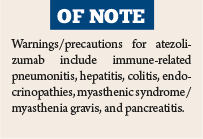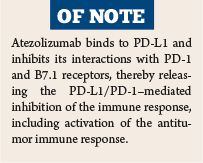In the Clinic provides overviews of novel oncology agents, addressing indications, mechanisms, administration recommendations, safety profiles, and other essential information needed for the appropriate clinical use of these drugs.
On October 18, 2016, the anti–PD-L1 (programmed cell death ligand 1) antibody atezolizumab (Tecentriq) was approved for the treatment of metastatic non–small cell lung cancer (NSCLC) progressing during or following platinum-containing chemotherapy.1,2 Patients with epidermal growth factor receptor (EGFR) or anaplastic lymphoma kinase (ALK) aberrations should have disease progression on U.S. Food and Drug Administration–approved therapy for these aberrations prior to receiving atezolizumab.
Supporting Efficacy Data
Approval was based on improved overall survival in two international randomized open-label clinical trials (OAK and POPLAR) comparing atezolizumab vs docetaxel in a total of 1,137 patients with NSCLC.2,3 In both studies (N = 850 in OAK and N = 287 in POPLAR), patients were randomized to receive atezolizumab at 1,200 mg intravenously every 3 weeks (n = 425 in OAK, n = 144 in POPLAR) or docetaxel at 75 mg/m2 every 3 weeks (n = 425, n = 143).
In OAK, median age was 64 years, 61% of patients were male, 70% were white, 74% had nonsquamous disease, 10% had a known EGFR mutation, 0.2% had known ALK rearrangements, 82% were current or previous smokers, Eastern Cooperative Oncology Group (ECOG) performance status was 0 (37%) or 1 in all patients, and 75% had received only 1 prior platinum-based regimen. In POPLAR, median age was 62 years, 59% were male, 79% were white, 66% had nonsquamous disease (66%), 7% had a known EGFR mutation, 1% had ALK rearrangements, 80% were current or previous smokers, ECOG performance status was 0 (33%) or 1 in all, and approximately two-thirds had received only 1 prior platinum-based regimen. In both studies, randomization was stratified by PD-L1 expression status in tumor-infiltrating immune cells, number of prior chemotherapy regimens, and histology.
Median overall survival in OAK was 13.8 months in the atezolizumab group vs 9.6 months in the docetaxel group (hazard ratio [HR] = 0.74, P = .0004). Median overall survival in POPLAR was 12.6 vs 9.7 months (HR = 0.69, 95% confidence interval = 0.52–0.92).
How It Works
Atezolizumab is a PD-L1–blocking monoclonal antibody that binds to PD-L1 and inhibits its interactions with programmed cell death protein 1 (PD-1) and B7.1 receptors. This action releases the PD-L1/PD-1–mediated inhibition of the immune response, including activation of the antitumor immune response without inducing antibody-dependent cellular cytotoxicity.

PD-L1 may be expressed on tumor cells or tumor-infiltrating immune cells and can contribute to inhibition of the antitumor immune response in the tumor microenvironment. Binding of PD-L1 to PD-1 and B7.1 receptors on T cells and antigen-presenting cells results in suppression of cytotoxic T-cell activity, T-cell proliferation, and cytokine production. In syngeneic mouse tumor models, blocking PD-L1 activity resulted in decreased tumor growth.
How It Is Used
The recommended dose of atezolizumab is 1,200 mg via intravenous infusion over 60 minutes every 3 weeks until disease progression or unacceptable toxicity. If the first infusion is tolerated, all subsequent infusions can be given over 30 minutes. Infusion should be interrupted or slowed for mild or moderate infusion reactions and discontinued for more severe reactions. No dose reductions of atezolizumab are recommended.
Approval of Atezolizumab
- Atezolizumab (Tecentriq) was approved for the treatment of metastatic non–small cell lung cancer progressing during or following platinum-containing chemotherapy.
- The recommended dose of atezolizumab is 1,200 mg via intravenous infusion over 60 minutes every 3 weeks until disease progression or unacceptable toxicity.
Atezolizumab should be withheld for grade 2 pneumonitis; aspartate transaminase (AST) or alanine transaminase (ALT) > 3 and up to 5 times upper limit of normal or total bilirubin > 1.5 and up to 3 times upper limit of normal; grade 2 or 3 diarrhea or colitis; symptomatic hypophysitis, adrenal insufficiency, hypothyroidism, hyperthyroidism, or grade 3 or 4 hyperglycemia; grade 2 ocular inflammatory toxicity; grade 2 or 3 pancreatitis, or grade 3 or 4 increases in amylase or lipase levels (> 2 times upper limit of normal); grade 3 or 4 infection; grade 2 infusion-related reactions; and grade 3 rash. Treatment may be resumed with recovery of adverse reactions to grade 0 or 1.
Atezolizumab should be permanently discontinued for grade 3 or 4 pneumonitis; AST or ALT > 5 times upper limit of normal or total bilirubin > 3 times upper limit of normal; grade 4 diarrhea or colitis; grade 4 hypophysitis; any grade myasthenic syndrome/myasthenia gravis, Guillain-Barré syndrome, or meningoencephalitis; grade 3 or 4 ocular inflammatory toxicity; grade 4 pancreatitis or any grade recurrent pancreatitis; grade 3 or 4 infusion-related reactions; and grade 4 rash.
Safety Profile
The primary safety population was that of the POPLAR trial. The most common adverse events of any grade in the atezolizumab group were fatigue (46%), decreased appetite (35%), dyspnea (32%), cough (30%), nausea (22%), musculoskeletal pain (22%), and constipation (20%). The most common grade 3 or 4 adverse reactions occurring in ≥ 2% of the atezolizumab group were dyspnea (7%), pneumonia (6%), hypoxia, hyponatremia, fatigue, anemia, musculoskeletal pain, AST increase, ALT increase, dysphagia, and arthralgia. The most common grade 3 or 4 laboratory abnormalities were hyponatremia (13%) and hypoalbuminemia (5%). Clinically significant immune-related adverse events in atezolizumab patients included pneumonitis, hepatitis, colitis, and thyroid disease.

Nine patients receiving atezolizumab (6%) had pulmonary embolism (n = 2), pneumonia (n =2), pneumothorax, ulcer hemorrhage, cachexia secondary to dysphagia, myocardial infarction, or large intestinal perforation leading to death. Adverse events led to atezolizumab discontinuation in 4% of patients and interruption in 24%. Serious adverse events occurred in 37%, with the most common being pneumonia, dyspnea, pleural effusion, pyrexia, and venous thromboembolism.
Atezolizumab carries warnings/precautions for immune-related pneumonitis; immune-related hepatitis; immune-related colitis; immune-related endocrinopathies, including hypophysitis, thyroid disorders, adrenal insufficiency, and type 1 diabetes; immune-related myasthenic syndrome/myasthenia gravis, Guillain-Barré syndrome or meningoencephalitis; ocular inflammatory toxicity; immune-related pancreatitis; infection; infusion reaction; and embryofetal toxicity. ■
References
1. U.S. Food and Drug Administration: Atezolizumab (Tecentriq). Available at www.fda.gov/Drugs/InformationOnDrugs/ApprovedDrugs/ucm525780.htm. Accessed October 21, 2016.
2. Tecentriq (atezolizumab) injection prescribing information, Genentech, October 2016. Available at www.accessdata.fda.gov/drugsatfda_docs/label/2016/761041lbl.pdf. Accessed October 21, 2016.
3. Fehrenbacher L, Spira A, Ballinger M, et al: Atezolizumab versus docetaxel for patients with previously treated non-small-cell lung cancer (POPLAR): A multicentre, open-label, phase 2 randomised controlled trial. Lancet 387:1837-1846, 2016.

